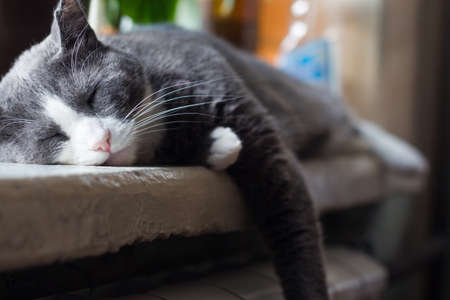1. Why Do Cats Sleep So Much?
If youve ever wondered why your cat seems to spend most of the day sleeping, youre not alone. Cats are known for their love of sleep, often snoozing anywhere from 12 to 16 hours a day, and sometimes even more! But why do they sleep so much? Understanding the biological and evolutionary reasons behind this behavior can help you better care for your feline friend.
The Evolutionary Instinct
Cats are natural hunters, and their sleep patterns are deeply rooted in their wild ancestors survival instincts. In the wild, big cats like lions and tigers conserve energy by sleeping for long periods so they can be alert and ready when it’s time to hunt. Domestic cats have inherited this trait, even though they don’t need to hunt for food anymore.
Energy Conservation
Hunting requires bursts of intense energy, and although your house cat may not be chasing prey in the jungle, their body is still wired for it. Sleeping helps them store up energy so they can engage in short, playful chases or pounce on their favorite toys with full force.
The Role of Age and Lifestyle
A cat’s age and daily routine also impact their sleep habits:
| Cat’s Life Stage | Average Sleep Time | Sleep Characteristics |
|---|---|---|
| Kittens | 18-20 hours | Growing bodies require extra rest. |
| Adult Cats | 12-16 hours | Balanced sleep cycles with active play periods. |
| Senior Cats | 16-20 hours | Aging bodies need more rest and recovery time. |
Weather and Comfort Factors
You might notice that your cat sleeps even more on rainy or colder days. Just like humans enjoy cozying up under blankets when it’s chilly outside, cats seek warmth and comfort by curling up for longer naps.
The Influence of Diet
A cat’s diet plays a role in how much they sleep. High-protein diets mimic what they would eat in the wild, leading them to follow similar energy cycles—long naps followed by short bursts of activity.
Should You Be Concerned?
While excessive sleeping is normal for most cats, sudden changes in sleep patterns could indicate underlying health issues. If your usually active cat starts sleeping significantly more than usual or shows other signs of lethargy, its best to consult a veterinarian.
By understanding why cats sleep so much, you can provide a comfortable environment that supports their natural instincts while ensuring they stay happy and healthy!
2. Common Cat Sleeping Positions and Their Meanings
Cats have a variety of sleeping positions, each revealing something about their mood, comfort level, and overall well-being. By understanding these positions, you can gain insight into how your feline friend is feeling.
The Loaf Position
In this position, your cat tucks its paws under its body while keeping its head up. This means they are relaxed but still somewhat alert. It’s a common resting posture when they don’t want to be disturbed but are not in a deep sleep.
The Curled-Up Ball
If your cat curls up into a tight ball with their tail wrapped around their body, it’s usually a sign that they want to conserve warmth and feel secure. This position is commonly seen in colder environments or when they need extra comfort.
The Side Sleeper
When a cat sleeps on its side with legs stretched out, it indicates that they feel completely safe and comfortable in their surroundings. This is often a deep sleep position, showing trust in their environment.
The Belly-Up Position
A cat lying on its back with its belly exposed is displaying total relaxation and trust. Since the belly is one of the most vulnerable areas, this position signals that your cat feels completely safe in their home.
The Superman Pose
This position involves your cat stretching out with their front legs extended forward and hind legs stretched back. It’s often seen in kittens and younger cats who are in a light sleep but ready to spring into action if needed.
The Head Tuck
If your cat tucks their head under their paw or tail while sleeping, it likely means they want uninterrupted rest. This position helps block out light and distractions, signaling that they prefer not to be disturbed.
Summary of Common Cat Sleeping Positions
| Sleeping Position | Meaning |
|---|---|
| The Loaf Position | Relaxed but still alert |
| The Curled-Up Ball | Seeking warmth and security |
| The Side Sleeper | Total comfort and deep sleep |
| The Belly-Up Position | Complete trust and relaxation |
| The Superman Pose | Light sleep with readiness to move |
| The Head Tuck | Avoiding light and distractions for deep rest |

3. Where Cats Prefer to Sleep and Why
Cats are known for their love of sleep, but have you ever wondered why they choose certain spots over others? Your cat’s favorite sleeping locations can reveal a lot about their sense of security, comfort, and even their relationship with you.
Understanding Your Cat’s Sleeping Preferences
Cats instinctively seek out places where they feel safe and comfortable. Their preferred sleeping spots are often influenced by factors like temperature, noise levels, and their bond with household members. Here are some common sleeping locations and what they might indicate:
| Sleeping Spot | Possible Reasons |
|---|---|
| Your Bed | Your scent provides comfort, and they feel safe near you. |
| A Sunny Window | Cats love warmth, and sunlight helps regulate their body temperature. |
| A High Shelf or Perch | Being elevated gives them a sense of security and a good vantage point. |
| An Enclosed Space (Box, Closet, Under Furniture) | Cats enjoy enclosed areas because they offer protection from potential threats. |
| A Pile of Laundry | The soft texture and familiar scent make it a cozy resting place. |
The Role of Security in Sleeping Choices
Cats are both predators and prey in the wild, so they instinctively choose sleeping locations that provide safety. If your cat prefers hidden or elevated spots, it could be because they feel more secure there. On the other hand, if they sleep in open areas or near you, it may indicate a strong bond and trust.
Your Cat’s Bond with You
If your cat chooses to sleep on or near you, it’s a sign of trust. Cats are selective about where they rest, so if they prefer your bed or lap, it means they see you as part of their safe space.
Helping Your Cat Feel Safe While Sleeping
If you want to encourage your cat to rest comfortably, consider providing cozy bedding in quiet areas of your home. Heated beds, soft blankets, or enclosed cat caves can help create an inviting sleep environment that makes them feel secure.
4. Nighttime Zoomies vs. Sleep Cycles
If you’ve ever been woken up by your cat sprinting through the house in the middle of the night, you’re not alone. Many cat owners experience what’s commonly known as “nighttime zoomies.” But why do cats suddenly become so active at night, and how does their sleep cycle differ from ours?
Why Are Cats More Active at Night?
Cats are crepuscular creatures, meaning they are naturally most active during dawn and dusk. This instinct comes from their wild ancestors, who hunted during these low-light periods to catch prey. While domesticated cats no longer need to hunt for food, this behavior is still hardwired into their instincts.
How Cat Sleep Cycles Differ from Humans
Unlike humans, who typically follow a monophasic sleep pattern (one long sleep period per day), cats have a polyphasic sleep pattern, meaning they take multiple naps throughout the day and night. Here’s a simple comparison of human and cat sleep cycles:
| Sleep Pattern | Humans | Cats |
|---|---|---|
| Main Sleep Period | 6-8 hours (continuous) | Short naps (typically 15-30 minutes each) |
| Total Sleep Per Day | Around 7-9 hours | Around 12-16 hours |
| Peak Activity Times | Daytime | Dawn and dusk |
How to Manage Your Cat’s Nighttime Energy
If your cat’s nighttime activity is keeping you awake, there are ways to help regulate their energy levels:
Create a Play Routine Before Bed
A good play session before bedtime can help burn off excess energy. Try using interactive toys like feather wands or laser pointers to mimic hunting behaviors.
Adjust Meal Times
Cats often feel sleepy after eating. Feeding your cat their largest meal right before bedtime can encourage them to rest rather than stay active.
Provide Engaging Daytime Activities
If your cat sleeps too much during the day, they’ll have more energy at night. Puzzle feeders, climbing structures, and window perches can help keep them engaged while youre away.
5. When to Be Concerned About Your Cat’s Sleep
Cats love to sleep, but sometimes changes in their sleeping patterns can indicate underlying health issues. As a pet owner, recognizing abnormal sleeping behaviors is crucial to ensuring your feline friend stays healthy.
Signs That Your Cat’s Sleep Patterns Might Indicate a Problem
While cats naturally sleep a lot, there are certain signs that might suggest something isn’t quite right. Keep an eye out for these unusual behaviors:
| Behavior | Possible Concern |
|---|---|
| Excessive Sleeping (More than Usual) | Could indicate illness, pain, or depression. |
| Trouble Waking Up or Extreme Lethargy | Might be a sign of an underlying medical issue such as diabetes or anemia. |
| Sleeps Very Little or Restlessly | Anxiety, discomfort, or hyperthyroidism could be the cause. |
| Loud Noises While Sleeping | If accompanied by labored breathing, it could indicate respiratory problems. |
| Avoiding Favorite Sleeping Spots | Pain or discomfort may be preventing them from resting comfortably. |
When to Contact a Veterinarian
If you notice any of the behaviors listed above persisting for more than a couple of days, its best to consult your veterinarian. Sudden changes in sleep habits, especially when paired with other symptoms like weight loss, lack of appetite, or excessive vocalization, should not be ignored.
The Importance of Observing Your Cat’s Daily Routine
Your cat’s sleep patterns provide valuable insight into their overall health. By keeping track of their usual behavior, you’ll be able to spot any unusual changes early on and take action if needed.
A Quick Tip: Keep a Sleep Log
If youre unsure whether your cats sleeping habits have changed significantly, try keeping a simple log. Record how long they sleep and where they prefer to rest. This can help you provide useful information to your vet if concerns arise.


